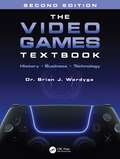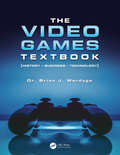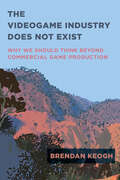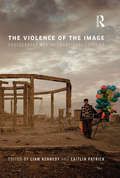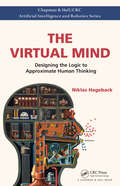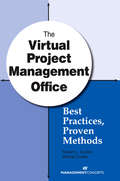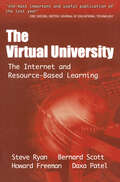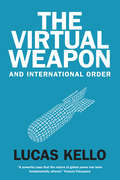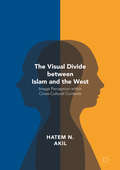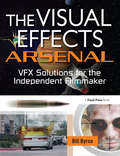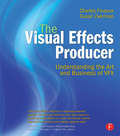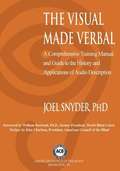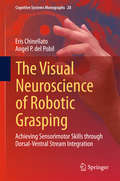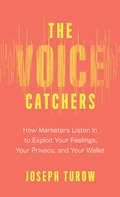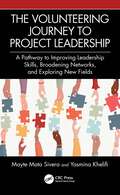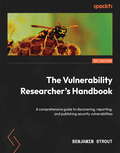- Table View
- List View
The Video Games Textbook: History • Business • Technology
by Brian J. WardygaThe Video Games Textbook takes the history of video games to the next level. Coverage includes every major video game console, handheld system, and game-changing personal computer, as well as a look at the business, technology, and people behind the games. Chapters feature objectives and key terms, illustrative timelines, color images, and graphs in addition to the technical specifications and key titles for each platform. Every chapter is a journey into a different segment of gaming, where readers emerge with a clear picture of how video games evolved, why the platforms succeeded or failed, and the impact they had on the industry and culture. Written to capture the attention and interest of students from around the world, this newly revised Second Edition also serves as a go-to handbook for any video game enthusiast. This edition features new content in every chapter, including color timelines, sections on color theory and lighting, the NEC PC-98 series, MSX series, Amstrad CPC, Sinclair ZX Spectrum, Milton Bradley Microvision, Nintendo Game & Watch, gender issues, PEGI and CERO rating systems, and new Pro Files and quiz questions, plus expanded coverage on PC and mobile gaming, virtual reality, Valve Steam Deck, Nintendo Switch, Xbox Series X|S, and PlayStation 5. Key Features Explores the history, business, and technology of video games, including social, political, and economic motivations Facilitates learning with clear objectives, key terms, illustrative timelines, color images, tables, and graphs Highlights the technical specifications and key titles of all major game consoles, handhelds, personal computers, and mobile platforms Reinforces material with market summaries and reviews of breakthroughs and trends, as well as end-of-chapter activities and quizzes
The Video Games Textbook: History, Business, Technology
by Brian J. WardygaThe Video Games Textbook takes the history of video games to another level, with visually-stimulating, comprehensive, and chronological chapters that are relevant and easy to read for a variety of students. Every chapter is a journey into a different era or area of gaming, where readers emerge with a strong sense of how video games evolved, why they succeeded or failed, and the impact they had on the industry and human culture. Written to capture the attention and interest of both domestic and international college students, each chapter contains a list of objectives and key terms, illustrative timelines, arcade summaries, images and technical specifications of all major consoles.
The Videogame Industry Does Not Exist: Why We Should Think Beyond Commercial Game Production
by Brendan KeoghThe precarious reality of videogame production beyond the corporate blockbuster studios of North America.The videogame industry, we're invariably told, is a multibillion-dollar, high-tech business conducted by large corporations in certain North American, European, and East Asian cities. But most videogames today, in fact, are made by small clusters of people working on shoestring budgets, relying on existing, freely available software platforms, and hoping, often in vain, to rise to stardom—in short, people working like artists. Aiming squarely at this disconnect between perception and reality, The Videogame Industry Does Not Exist presents a much more accurate and nuanced picture of how the vast majority of videogame-makers work—a picture that reveals the diverse and precarious communities, identities, and approaches that make videogame production a significant cultural practice.Drawing on insights provided by over 400 game developers across Australia, North America, Europe, and Southeast Asia, Brendan Keogh develops a new framework for understanding videogame production as a cultural field in all its complexity. Part-time hobbyists, aspirational students, client-facing contractors, struggling independents, artist collectives, and tightly knit local scenes—all have a place within this model. But proponents of non-commercial game making don't exist in isolation; Keogh shows how they and their commercial counterparts are deeply interconnected and codependent in the field of videogame production.A cultural intervention, The Videogame Industry Does Not Exist challenges core assumptions about videogame production—ideas about creativity, professionalism, labor, diversity, education, globalization, and community. Its in-depth, complex portrayal suggests new ways of seeing, and engaging in, the videogame industry that really does exist.
The View from Flyover Country: Dispatches from the Forgotten America
by Sarah KendziorFrom the St. Louis–based journalist often credited with first predicting Donald Trump’s presidential victory."A collection of sharp-edged, humanistic pieces about the American heartland...Passionate pieces that repeatedly assail the inability of many to empathize and to humanize." — KirkusIn 2015, Sarah Kendzior collected the essays she reported for Al Jazeera and published them as The View from Flyover Country, which became an ebook bestseller and garnered praise from readers around the world. Now, The View from Flyover Country is being released in print with an updated introduction and epilogue that reflect on the ways that the Trump presidency was the certain result of the realities first captured in Kendzior’s essays.A clear-eyed account of the realities of life in America’s overlooked heartland, The View from Flyover Country is a piercing critique of the labor exploitation, race relations, gentrification, media bias, and other aspects of the post-employment economy that gave rise to a president who rules like an autocrat. The View from Flyover Country is necessary reading for anyone who believes that the only way for America to fix its problems is to first discuss them with honesty and compassion.“Please put everything aside and try to get ahold of Sarah Kendzior’s collected essays, The View from Flyover Country. I have rarely come across writing that is as urgent and beautifully expressed. What makes Kendzior’s writing so truly important is [that] it . . . documents where the problem lies, by somebody who lives there.”—The Wire“Sarah Kendzior is as harsh and tenacious a critic of the Trump administration as you’ll find. She isn’t some new kid on the political block or a controversy machine. . . .Rather she is a widely published journalist and anthropologist who has spent much of her life studying authoritarianism.” —Columbia Tribune
The VimL Primer: Edit Like a Pro with Vim Plugins and Scripts
by Benjamin KleinBuild on your editor's capabilities and tailor your editing experience with VimL, the powerful scripting language built into Vim. With VimL you can configure basic settings or add entirely new functionality. Use this quick and easy introduction to create your own Vim plugin while learning the concepts and syntax of VimL.VimL is the scripting language of the Vim editor. If you've ever edited or saved a vimrc file, you've written VimL. And VimL can do much more than simply configure settings and specify option values--you can write entire plugins in VimL. But without a background in scripting Vim, it can be hard to know where to start.The VimL Primer gives you the tools and confidence you need. It gets you comfortable in VimL quickly, walking you through creating a working plugin that you can run yourself as you write it in Vim. You'll learn how to script common commands and buffer interaction, work with windows and buffers from within a plugin script, and how to use autocommands to have Vim recognize entirely new filetypes. You'll discover how to declare filetype-specific settings and define your own syntax elements for use with Vim's syntax highlighting. And you'll see how you can write your own command-line commands and define new mappings to call them.With this introduction to scripting Vim, your own Vim extensions are only plugins away. Take control of your editor!What You Need::Vim version 7 or later is required, and it's available on any of the major operating systems. This book uses the "Huge" version of Vim 7.4.
The Violence of the Image: Photography and International Conflict (International Library Of Visual Culture Ser.)
by Liam KennedyPhotography has visualized international relations and conflicts from the midnineteenth century onwards and continues to be an important medium in framing the worlds of distant, suffering others. Although photojournalism has been challenged in recent decades, claims that it is dead are premature. The Violence of the Image examines the roles of image producers and the functions of photographic imagery in the documentation of wars, violent conflicts and human rights issues; tackling controversial ideas such as 'witnessing', the making of appeals based on displays of human suffering and the much-cited concept of 'compassion fatigue'. In the twenty-first century, the advent of digital photography, camera phones and socialmedia platforms has altered the relationship between photographers, the medium and the audience- as well as contributing to an ongoing blurring of the boundaries between news and entertainment and professional and amateur journalism. The Violence of the Image explores how new vernacular and artistic modes of photographic production articulate international friction.This innovative, timely book makes a major contribution to discussions about the power of the image in conflict.
The Virtual Assistants Guide to Marketing: The VA Approach to Marketing Your Services (2nd edition)
by Michelle JamisonThis book recommends building relationships by providing superior customer service, building trust and confidence and, by doing so, generating word-of-mouth and referrals.
The Virtual Future
by William Sims BainbridgeThe newest communication technologies are profoundly changing the world's politics, economies, and cultures, but the specific implications of online game worlds remain mysterious. The Virtual Future employs theories and methods from social science to explore nine very different virtual futures: The Matrix Online, Tabula Rasa, Anarchy Online, Entropia Universe, Star Trek Online, EVE Online, Star Wars Galaxies, World of Warcraft: Burning Crusade, and The Chronicles of Riddick. Each presents a different picture of how technology and society could evolve in coming centuries, but one theme runs through all of them, the attempt to escape the Earth and seek new destinies among the stars. Four decades after the last trip to the moon, a new conception of spaceflight is emerging. Rather than rockets shooting humans across vast physical distances to sterile rocks that lack the resources to sustain life, perhaps robot space probes and orbiting telescopes will glean information about the universe, that humans can then experience inside computer-generated environments much closer to home. All nine of these fantastically rich multiplayer masterpieces have shown myriads of people that really radical alternatives to contemporary society could exist, and has served as a laboratory for examining the consequences. Each is a prototype of new social forms, a utopian subculture, and a simulation of technologies that have yet to be invented. They draw upon several different traditions of science fiction and academic philosophy, and they were created in several nations. By comparing these nine role-playing fantasies, we can better consider what kind of world we want to inhabit in the real future.
The Virtual Mind: Designing the Logic to Approximate Human Thinking (Chapman & Hall/CRC Artificial Intelligence and Robotics Series)
by Niklas HagebackThe Virtual Mind: Designing the Logic to Approximate Human Thinking, through an in-depth and multidisciplinary review, outlines and defines the underpinnings for modelling human thinking through approximating the mind. Whilst there are plenty of efforts underway trying to mimic the brain, its complexities have so far proven insurmountable. But replicating the abstract notion of the mind provides a viable and quicker route. Broadly, the mind consists of a conscious and an unconscious part with separate logic schemes and these absorbs reality in diverging chunks, with the former truncated through narratives and norms and the latter able to amass broader perceptions of reality. These are held together and controlled through a governing mechanism. With the replication and establishment of the mind’s mechanistic rules and dynamic constants, tested through a big data approach from public media, it allows for standardization and machine generated human thinking, a Virtual Mind.A virtual mind is able to cover a wide array of applications, in particular forecasting of human behavior and decision-making. In essence, the whole socioeconomic spectra can be captured, including politics, financial markets and consumer patterns. Another area of potential application would be to augment various game software and of course, it would be applicable for the man-machine connect.The book guides the reader on how to develop and produce a machine generated virtual mind in a step-by-step manner. It is a must for anyone with an interest in artificial intelligence, the design and construction of the next generation of computer logic and it provides an enhanced understanding of mankind’s greatest mystery, the workings of the mind. Niklas Hageback has extensive experience of risk modelling and financial analytics working at tier-one financial institutions and consulting firms, such as Deutsche Bank, KPMG, and Goldman Sachs, where he held regional executive risk management and oversight roles in both Europe and Asia.
The Virtual Project Management Office: Best Practices, Proven Methods
by Robert L. Gordon DM Wanda Curlee DM, PMP, PgMP, PMI-RMPSuccessfully Launch and Operate a Virtual Project Management OfficeNew technology and global businesses and organizations are making virtual project management offices (VPMOs) more important and more prevalent than ever. Successfully operating a VPMO requires project managers to employ additional skills and address different challenges from those necessary to operate a traditional PMO. For example, the virtual project manager must have effective soft skills to build trust among a dispersed team and to select the best forms of communication. He or she must also ensure compliance with the unique policies, procedures, and laws relevant to maintaining a VPMO.This book offers best practices for successful virtual projects and the most effective ways to create and implement a PMO in a virtual environment. It's a valuable resource for companies considering a VPMO and those already operating one.You'll find:- Proven implementation plans- Guidance for building a business case- Laws and ethics governing VPMOs- Tips and advice from expertsPlus! Dozens of practical tools to use in launching a VPMO or improving an existing project management office.
The Virtual University: The Internet and Resource-based Learning (Open and Flexible Learning Series)
by Howard Freeman Bernard Scott Steve Ryan Daxa PatelA discussion of the increased accessibility to the Internet and how this has lead to a variety of resources being used for learning. Case studies and examples show the benefits of using the Internet as part of resource-based learning.
The Virtual Weapon and International Order
by Lucas KelloAn urgently needed examination of the current cyber revolution that draws on case studies to develop conceptual frameworks for understanding its effects on international order The cyber revolution is the revolution of our time. The rapid expansion of cyberspace brings both promise and peril. It promotes new modes of political interaction, but it also disrupts interstate dealings and empowers non-state actors who may instigate diplomatic and military crises. Despite significant experience with cyber phenomena, the conceptual apparatus to analyze, understand, and address their effects on international order remains primitive. Here, Lucas Kello adapts and applies international relations theory to create new ways of thinking about cyber strategy. Kello draws on a broad range of case studies, including the Estonian crisis, the Olympic Games operation against Iran, and the cyber attack against Sony Pictures. Synthesizing qualitative data from government documents, forensic reports of major incidents and interviews with senior officials from around the globe, this important work establishes new conceptual benchmarks to help security experts adapt strategy and policy to the unprecedented challenges of our times.
The Visual Divide between Islam and the West
by Hatem N. AkilThis book considers the ways in which Muslims view the way they are being viewed, not viewed, or incorrectly viewed, by the West. The book underscores a certain "will-to-visibility" whereby Muslims/ Arabs wish just to be "seen" and to be marked as fellow human beings. The author relates the failure to achieve this visibility to a state of desperation that inextricably and symmetrically ties visibility to violence. When Syrian and Palestinian refugees recently started refusing to be photographed, they clearly ushered the eventual but inevitable collapse of the image and its final futility. The photograph has been completely emptied of its last remaining possibility of signification. The book attempts to engage with questions about the ways in which images are perceived within cross cultural contexts. Why and how do people from different cultural backgrounds view the same image in opposing ways; why do cartoon, photographs, and videos become both the cause and target of bloody political violence - as witnessed recently by the deadly attacks against Charlie Hebdo in France and in the swift military response by the US, Jordan, France, and others to videotaped violence by ISIS.
The Visual Effects Arsenal: VFX Solutions for the Independent Filmmaker
by Bill ByrneBuild your VFX arsenal with quick-access, step-by-step instruction on how to create today's hottest digital VFX shots. This essential toolkit provides techniques for creating effects seen in movies such as 300, Spiderman 3, Predator and others, with lessons on how-to:* splatter blood or digitally lop someone's arm off* create a scene with actors running from an explosion* create the "twin effect" (same actor, same location, 2 performances)* produce space-ship dog fightsOrganized in a 'cookbook' style, this allows you to reference a certain effect in the index and immediately access concise instructions to create that effect. Techniques are demonstrated in each of the most popular software tools- After Effects, Final Cut Studio, Photoshop, and Combustion are all covered. Brilliant, 4-color presentation provides inspiration and stimulating visual guidance to the lessons presented, while the downloadable resources contain project media files enabling you to put concepts learned into immediate practice.
The Visual Effects Producer: Understanding the Art and Business of VFX
by Susan Zwerman Charles FinanceFirst published in 2010. Routledge is an imprint of Taylor & Francis, an informa company.
The Visual Made Verbal: A Comprehensive Training Manual and Guide to the History and Applications of Audio Description
by Joel SnyderVerbal descriptions of life have been around for centuries, but the digital age has made access to those descriptions even more important. Dr. Joel Snyder, an audio description pioneer, has created a book and website offering the first overview of the field, including its history, application to a range of genres, description of training techniques and list of resources. Audio description brings the visual world to life, making theater productions, television shows, films, visual art and events accessible to people who are blind or have low vision. Describers employ succinct, vivid, imaginative words to convey visual images those with sight take for granted. Although countries worldwide have taken up the cause, the United States has fallen short on research and institutions to study the field. Dr. Snyder's book helps fill in some of those gaps. "For decades, Joel Snyder has combined his astonishing command of language with his keen attention to detail to create word pictures that stir the mind's eye, especially for patrons of the arts whose physical eyes cannot see. ... His book has been long-awaited and no doubt will become the standard for prospective audio describers around the world." -- Kelsey Marshall, founding director of accessibility, John F. Kennedy Center for the Performing Arts in Washington, D.C. Dr. Joel Snyder is known internationally as one of the world's first "audio describers," a pioneer in the field of audio description: making theater events, museum exhibitions, and media accessible to people who are blind or have low vision. Since 1981, he has introduced audio description techniques in 36 states and D.C. and in 35 countries; he holds a Ph.D. in accessibility-audio description from the Universitat Autonoma de Barcelona. Dr. Snyder's company, Audio Description Associates, LLC (www.audiodescribe.com) uses audio description to enhance a wide range of arts projects including video and film, museum exhibitions and live events, As Director of Described Media for the National Captioning Institute, he supervised the production of description for Sesame Street and dozens of feature films and nationally broadcast television; his descriptions can be heard at Smithsonian Institution exhibits, the Getty Museum, the Albright-Knox Gallery and throughout the country at National Park Service visitor centers. As Director of the American Council of the Blind's Audio Description Project (www.acb.org/adp), Dr. Snyder voiced description for network coverage of President Obama's inauguration in 2009 and 2013 and recently produced the first-ever audio described tour of The White House; the ADP website is the nation's principal provider of information and resources on audio description.
The Visual Neuroscience of Robotic Grasping
by Eris Chinellato Angel P. PobilThis book presents interdisciplinary research that pursues the mutual enrichment of neuroscience and robotics. Building on experimental work, and on the wealth of literature regarding the two cortical pathways of visual processing - the dorsal and ventral streams - we define and implement, computationally and on a real robot, a functional model of the brain areas involved in vision-based grasping actions. Grasping in robotics is largely an unsolved problem, and we show how the bio-inspired approach is successful in dealing with some fundamental issues of the task. Our robotic system can safely perform grasping actions on different unmodeled objects, denoting especially reliable visual and visuomotor skills. The computational model and the robotic experiments help in validating theories on the mechanisms employed by the brain areas more directly involved in grasping actions. This book offers new insights and research hypotheses regarding such mechanisms, especially for what concerns the interaction between the dorsal and ventral streams. Moreover, it helps in establishing a common research framework for neuroscientists and roboticists regarding research on brain functions.
The Visual Organization
by Phil SimonThe era of Big Data as arrived, and most organizations are woefully unprepared. Slowly, many are discovering that stalwarts like Excel spreadsheets, KPIs, standard reports, and even traditional business intelligence tools aren't sufficient. These old standbys can't begin to handle today's increasing streams, volumes, and types of data. Amidst all of the chaos, though, a new type of organization is emerging. In The Visual Organization, award-winning author and technology expert Phil Simon looks at how an increasingly number of organizations are embracing new dataviz tools and, more important, a new mind-set based upon data discovery and exploration. Simon adroitly shows how Amazon, Apple, Facebook, Google, Twitter, and other tech heavyweights use powerful data visualization tools to garner fascinating insights into their businesses. But make no mistake: these companies are hardly alone. Organizations of all types, industries, sizes are representing their data in new and amazing ways. As a result, they are asking better questions and making better business decisions.Rife with real-world examples and case studies, The Visual Organization is a full-color tour-de-force.
The Vogue of Managing People in Workplace (Innovations in Sustainable Technologies and Computing)
by Nilanjan Dey Soumi MajumderThis book provides a detailed vogue picture of workforce management. Nowadays, the methodology of people management has been more advanced and dynamic; it becomes highly competitive. Keeping in mind the significance of economic and social development of the country, the author has tried to draw attention on innovative and creative practices of workforce retention in business. The book provides an idea on the way of merchandising with people, cultural dynamics with impacted leadership, investment in people for organizational transformation and the future of people management with artificial intelligence.
The Voice Catchers: How Marketers Listen In to Exploit Your Feelings, Your Privacy, and Your Wallet
by Joseph TurowYour voice as biometric data, and how marketers are using it to manipulate you Only three decades ago, it was inconceivable that virtually entire populations would be carrying around wireless phones wherever they went, or that peoples&’ exact locations could be tracked by those devices. We now take both for granted. Even just a decade ago the idea that individuals&’ voices could be used to identify and draw inferences about them as they shopped or interacted with retailers seemed like something out of a science fiction novel. Yet a new business sector is emerging to do exactly that. The first in-depth examination of the voice intelligence industry, The Voice Catchers exposes how artificial intelligence is enabling personalized marketing and discrimination through voice analysis. Amazon and Google have numerous patents pertaining to voice profiling, and even now their smart speakers are extracting and using voice prints for identification and more. Customer service centers are already approaching every caller based on what they conclude a caller&’s voice reveals about that person&’s emotions, sentiments, and personality, often in real time. In fact, many scientists believe that a person&’s weight, height, age, and race, not to mention any illnesses they may have, can also be identified from the sound of that individual&’s voice. Ultimately not only marketers, but also politicians and governments, may use voice profiling to infer personal characteristics for selfish interests and not for the benefit of a citizen or of society as a whole. Leading communications scholar Joseph Turow places the voice intelligence industry in historical perspective, explores its contemporary developments, and offers a clarion call for regulating this rising surveillance regime.
The Volunteering Journey to Project Leadership: A Pathway to Improving Leadership Skills, Broadening Networks, and Exploring New Fields
by Mayte Mata Sivera Yasmina KhelifiThe project management profession has grown through the hard work of many volunteer groups and organizations. The Volunteering Journey to Project Leadership explains how volunteering can help project management professionals grow their own capabilities and careers. It explains how volunteering in project-oriented organizations, or any organization where projects are delivered, can help project managers develop leadership skills, build strong and diverse networks, and gain experiences in new fields. Any project manager or PMO can get advice and insights from this book, which explains how to: Identify volunteering goals that align with career goals Find the right organization that complements professional aspiration Choose activities for enhancing careers in project leadership Strategically select the right role to advance careers Based on the authors’ own volunteering and professional experiences, as well as interviews and informal discussion with more than 100 volunteers, this book is a hands-on guide to personal and professional growth in the field of project management. It is structured in three parts. Part I describes four ways volunteering can develop project leadership abilities. Part II focuses on leadership and adaptative skills, networking, and new skills gained by experimenting. Part III consolidates the learning and explains how to apply it at work. Each chapter ends with practical case studies, detailed interviews, key takeaways, and questions to reflect on.
The VueScan Bible
by Sascha SteinhoffVueScan is the world's most widely used software interface for digitizing film and prints on flatbed and film scanners. This powerful yet affordable program supports over 1500 scanners and 321 digital camera RAW file types, and is available for Mac OS X, Windows, and Linux. Much more than a simple scanner program, VueScan allows you to perform functions such as color restoration, adding sharpening filters, adjusting white balance, rotating images, and batch scanning multiple images. It also provides output to a variety of formats including TIFF, JPEG, and searchable PDF files (even all three simultaneously). The Pro version outputs to the RAW format and provides options for color adjustments, and more. Despite its popularity, the documentation for VueScan does not provide enough information to use the full power of the system and makes it difficult to get started. The VueScan Bible is the missing manual for new, experienced, and prospective users of VueScan.
The Vulnerability Researcher's Handbook: A comprehensive guide to discovering, reporting, and publishing security vulnerabilities
by Benjamin StroutLearn the right way to discover, report, and publish security vulnerabilities to prevent exploitation of user systems and reap the rewards of receiving credit for your workKey FeaturesBuild successful strategies for planning and executing zero-day vulnerability researchFind the best ways to disclose vulnerabilities while avoiding vendor conflictLearn to navigate the complicated CVE publishing process to receive credit for your researchBook DescriptionVulnerability researchers are in increasingly high demand as the number of security incidents related to crime continues to rise with the adoption and use of technology. To begin your journey of becoming a security researcher, you need more than just the technical skills to find vulnerabilities; you'll need to learn how to adopt research strategies and navigate the complex and frustrating process of sharing your findings. This book provides an easy-to-follow approach that will help you understand the process of discovering, disclosing, and publishing your first zero-day vulnerability through a collection of examples and an in-depth review of the process.You'll begin by learning the fundamentals of vulnerabilities, exploits, and what makes something a zero-day vulnerability. Then, you'll take a deep dive into the details of planning winning research strategies, navigating the complexities of vulnerability disclosure, and publishing your research with sometimes-less-than-receptive vendors.By the end of the book, you'll be well versed in how researchers discover, disclose, and publish vulnerabilities, navigate complex vendor relationships, receive credit for their work, and ultimately protect users from exploitation. With this knowledge, you'll be prepared to conduct your own research and publish vulnerabilities.What you will learnFind out what zero-day vulnerabilities are and why it's so important to disclose and publish themLearn how vulnerabilities get discovered and published to vulnerability scanning toolsExplore successful strategies for starting and executing vulnerability researchDiscover ways to disclose zero-day vulnerabilities responsiblyPopulate zero-day security findings into the CVE databasesNavigate and resolve conflicts with hostile vendorsPublish findings and receive professional credit for your workWho this book is forThis book is for security analysts, researchers, penetration testers, software developers, IT engineers, and anyone who wants to learn how vulnerabilities are found and then disclosed to the public. You'll need intermediate knowledge of operating systems, software, and interconnected systems before you get started. No prior experience with zero-day vulnerabilities is needed, but some exposure to vulnerability scanners and penetration testing tools will help accelerate your journey to publishing your first vulnerability.
The War Against the BBC: How an Unprecedented Combination of Hostile Forces Is Destroying Britain's Greatest Cultural Institution... And Why You Should Care
by Patrick Barwise Peter YorkThere's a war on against the BBC. It is under threat as never before. And if we lose it, we won't get it back.The BBC is our most important cultural institution, our best-value entertainment provider, and the global face of Britain. It's our most trusted news source in a world of divisive disinformation. But it is facing relentless attacks by powerful commercial and political enemies, including deep funding cuts - much deeper than most people realise - with imminent further cuts threatened. This book busts the myths about the BBC and shows us how we can save it, before it's too late.
The Warcraft Civilization: Social Science in a Virtual World (The\mit Press Ser.)
by William Sims BainbridgeAn exploration of the popular online role-playing game World of Warcraft as a virtual prototype of the real human future.World of Warcraft is more than a game. There is no ultimate goal, no winning hand, no princess to be rescued. WoW is an immersive virtual world in which characters must cope in a dangerous environment, assume identities, struggle to understand and communicate, learn to use technology, and compete for dwindling resources. Beyond the fantasy and science fiction details, as many have noted, it's not entirely unlike today's world. In The Warcraft Civilization, sociologist William Sims Bainbridge goes further, arguing that WoW can be seen not only as an allegory of today but also as a virtual prototype of tomorrow, of a real human future in which tribe-like groups will engage in combat over declining natural resources, build temporary alliances on the basis of mutual self-interest, and seek a set of values that transcend the need for war.What makes WoW an especially good place to look for insights about Western civilization, Bainbridge says, is that it bridges past and future. It is founded on Western cultural tradition, yet aimed toward the virtual worlds we could create in times to come.
